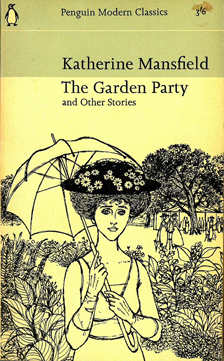Katherine Mansfield: ‘At the Bay’
by Charlie Hill
1964 Penguin edition of The Garden Party
However you choose to dissect her best work, (and she did do some that wasn’t all that), Katherine Mansfield was a revolutionary writer. She was a symbolist and a modernist and her stories were, according to katherinemansfield.com, the “first of significance in English to be written without a conventional plot.” Commenting on Somerset Maugham’s ‘Rain’, she made clear her distrust of the artifice of narrative. “It’s too downright good a story,” she said, “too oily.” She had no time for the resolvable either, preferring to avoid ‘subjects’ – and writing about ‘things’ – in favour of an emphasis on ‘absence’: “With all that one knows how much does one not know? The unknown is far, far greater than the known.” And, of course, at her best she was truly fearless: “Risk! Risk anything! Care no more for the opinions of others, for those voices. Do the hardest thing on earth for you. Act for yourself. Face the truth.”
My favourite Mansfield short story is ‘At the Bay’. Its length is not typical of her work – being 50 Penguin Classic pages long – but it couldn’t have been written by anyone else. The story is the first in her last collection – The Garden Party – which was published in 1922. It describes a day in the life of a small rural community in New Zealand. It is divided into twelve sections. There is no narrative arc. For the academic or the critic, the story is full of references and implications, to classical literature and myth, to the Bible and for the development of short storytelling; it goes back to Baudelaire, underscores Woolf. It is, it seems, about nothing in particular and everything at once. If you want to learn about this – and see how it provides evidence of Mansfield’s revolutionary credentials – you could start by going here. Alternatively, subscribe and read the piece by Kirsty Gunn in the London Review of Books, the best short appraisal of Mansfield’s work I have read.
All of which is, of course, important stuff. Such engagement enhances our understanding and appreciation of the significance of Mansfield’s work. But when I first read ‘At the Bay’ it wasn’t as an academic or critic, it was as a reader. And none of this would have mattered quite so much were it not for her prose. And her prose! Even before I’d read the story, I wanted to write like Katherine Mansfield in ‘At the Bay’. Here, for example, it is simultaneously economical and gloriously fat, a lyric prose that could have come from Dylan Thomas’ Portrait of the Artist as a Young Dog, thirty years later:
“A few moments later the back door of one of the bungalows opened, and a figure in a broad-striped bathing suit flung down the paddock, cleared the stile, rushed through the tussock grass into the hollow, staggered up the sandy hillock, and raced for dear life over the big porous stones, over the cold, wet pebbles, on to the hard sand that gleamed like oil.”
Here it is uncompromising, politically charged:
“Linda frowned; she sat up quickly in her steamer chair and clasped her ankles. Yes, that was her real grudge against life; that was what she could not understand. That was the question she asked and asked, and listened in vain for the answer. It was all very well to say it was the common lot of women to bear children. It wasn’t true. She, for one, could prove that wrong. She was broken, made weak, her courage was gone, through child-bearing. And what made it doubly hard to bear was, she did not love her children. It was useless pretending. Even if she had had the strength she never would have nursed and played with the little girls. No, it was as though a cold breath had chilled her through and through on each of those awful journeys; she had no warmth left to give them.”
And here it manages to be both informal and inviting but complex too:
“Dazzling white the picotees shone; the golden-eyed marigold glittered; the nasturtiums wreathed the veranda poles in green and gold flame. If only one had time to look at these flowers long enough, time to get over the sense of novelty and strangeness, time to know them! But as soon as one paused to part the petals, to discover the under-side of the leaf, along came Life and one was swept away. And, lying in her cane chair, Linda felt so light; she felt like a leaf. Along came Life like a wind and she was seized and shaken; she had to go. Oh dear, would it always be so? Was there no escape?”
Notwithstanding her revolutionary chops then (and clearly you can’t divorce the two), the joy of Katherine Mansfield’s writing is in its variety. She could do it all: in ‘At the Bay’, she does.
 Charlie Hill’s short stories have appeared in Ambit, Stand and The View From Here. His second novel Books is published by Tindal Street Press: read an extract in Bookanista.
Charlie Hill’s short stories have appeared in Ambit, Stand and The View From Here. His second novel Books is published by Tindal Street Press: read an extract in Bookanista.
charliehill.org.uk
Read ‘At the Bay’ at the Katherine Mansfield Society archive. The story is included in Wordsworth Classics’ and Penguin Classics’ The Collected Stories of Katherine Mansfield, Oxford World’s Classics’ Selected Stories and other collections.

